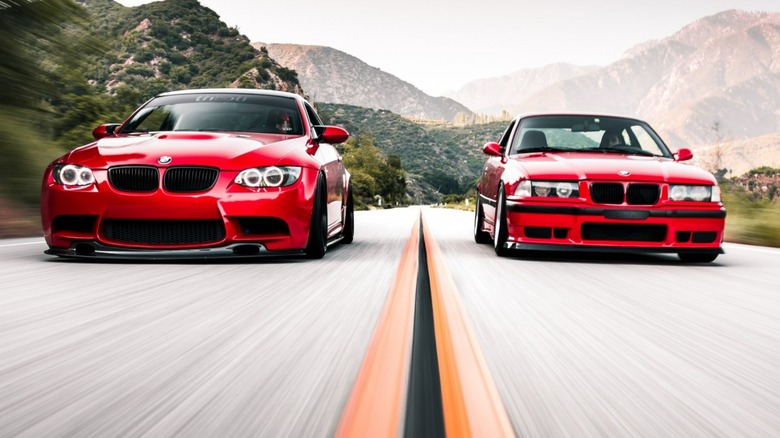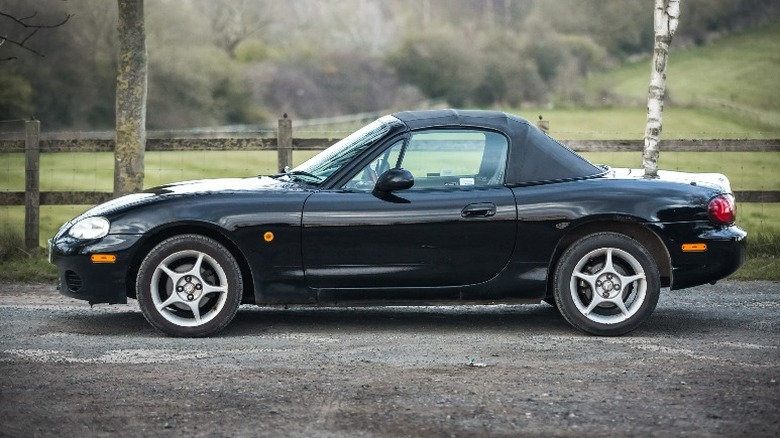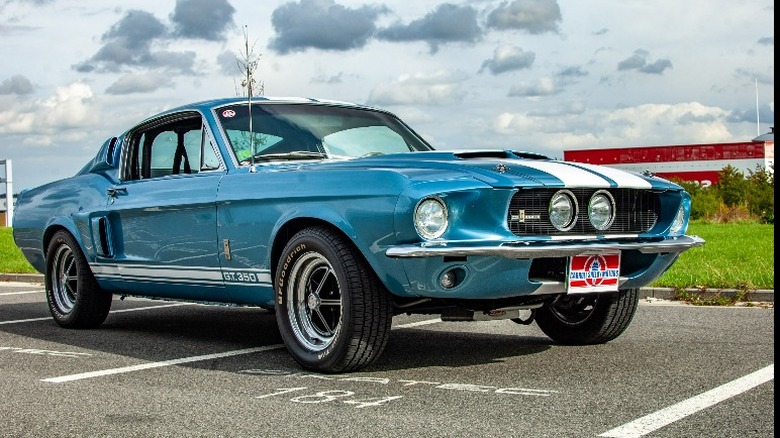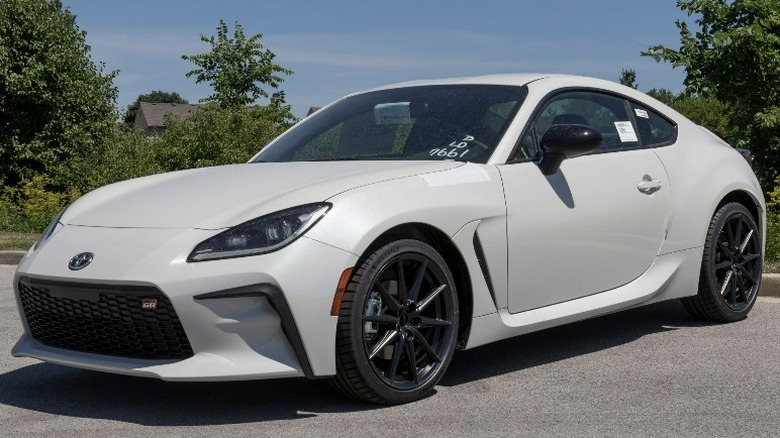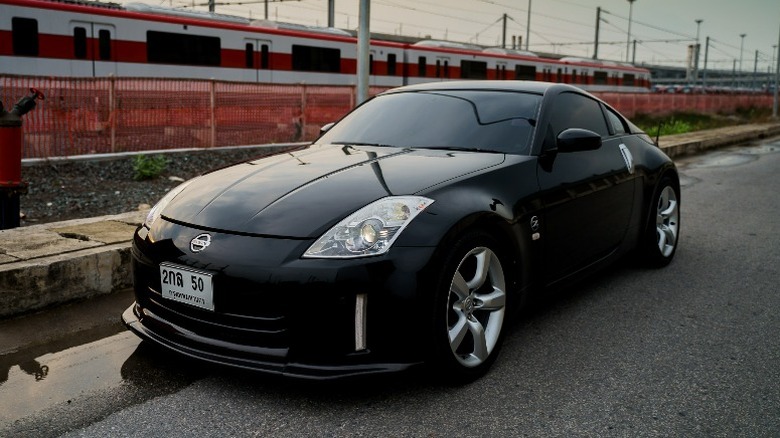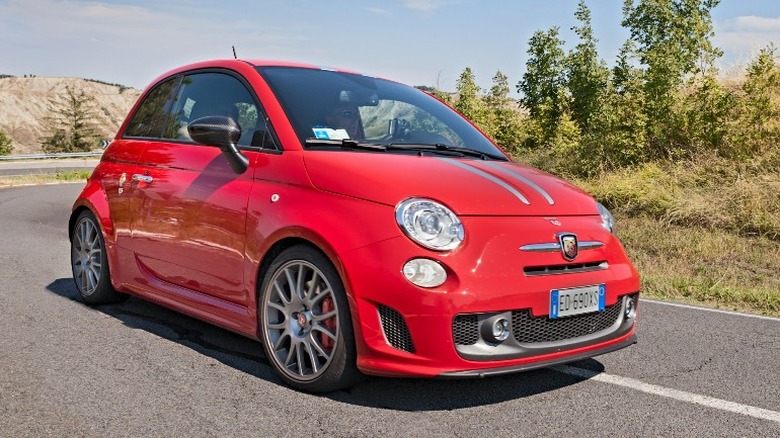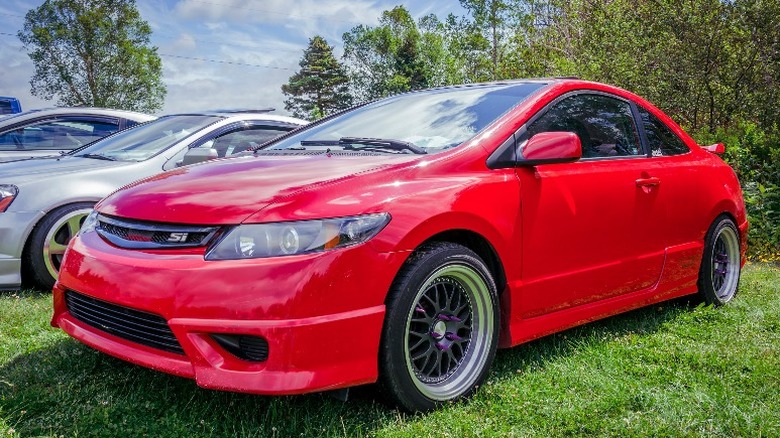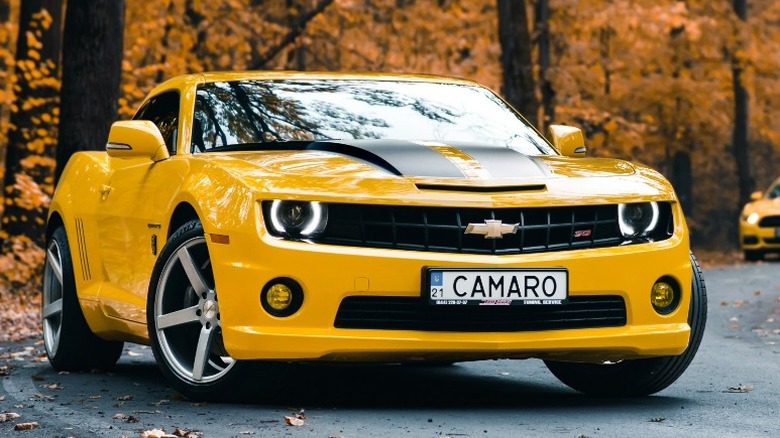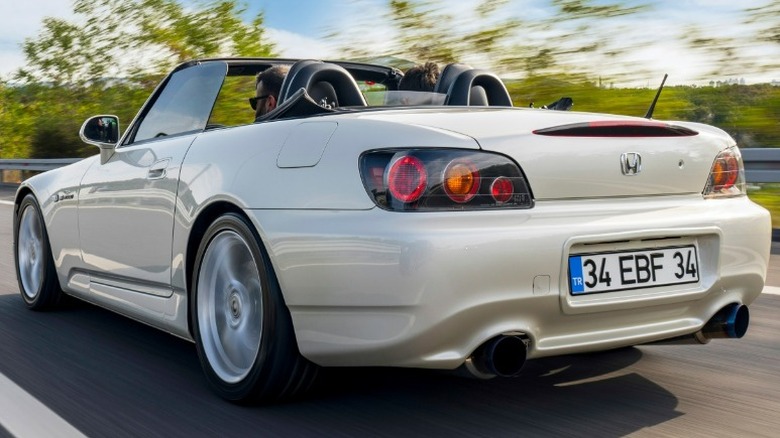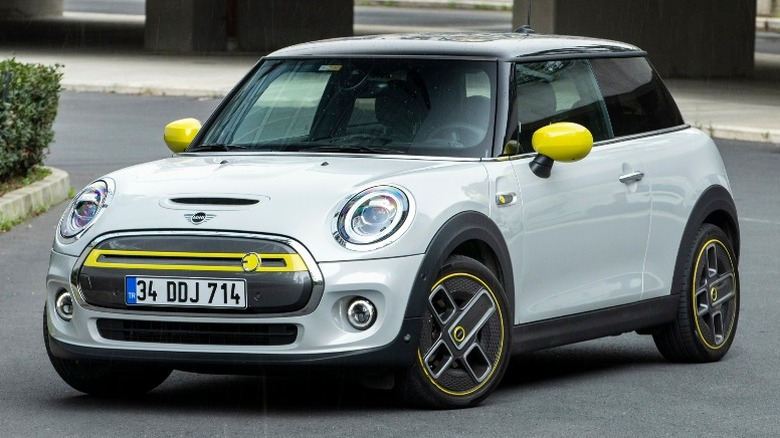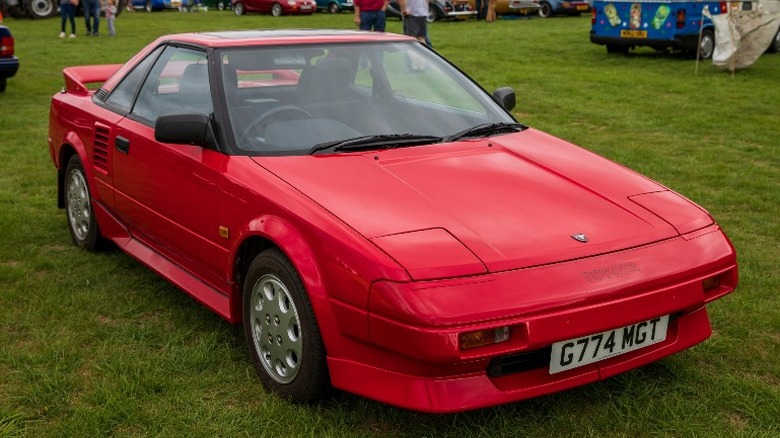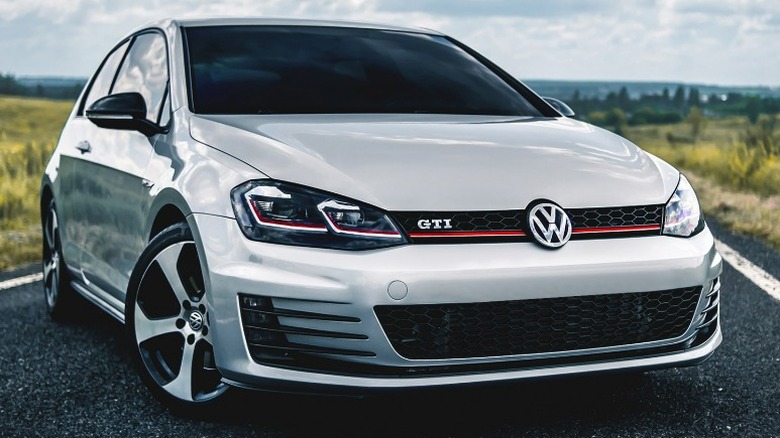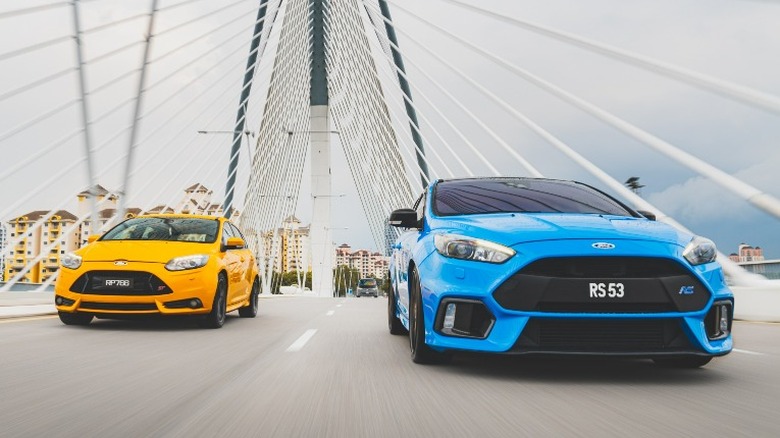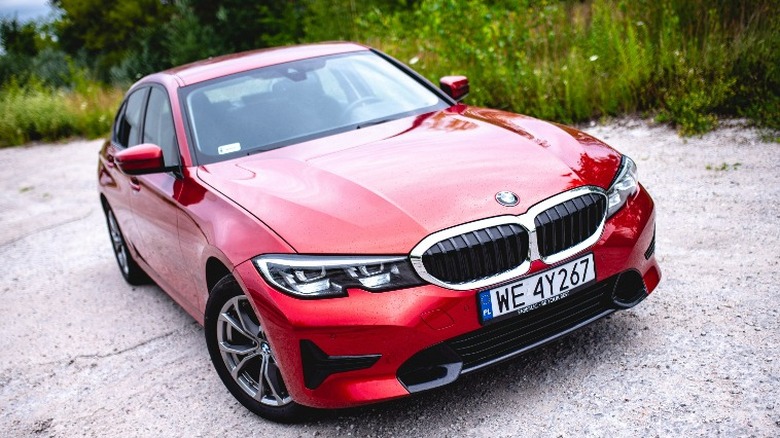13 Of The Best Track Day Cars For Beginners
While driving through the turns on a deserted mountain can provide hours of entertainment for the sports car enthusiast, most would consider an afternoon on a challenging racetrack, pushing the limits of performance and handling, the ultimate pleasure. For the beginner, taking the daily driver to the track poses some risks. Not only does it cause excessive wear and tear, but on a bad track day the car that gets you to work or the grocery store can end up in the repair shop for weeks.
A second car, purchased specifically for track use, might be the best solution for a beginner. It requires a minimum purchase investment and less expensive maintenance while the owner hones the skills needed to properly handle the racetrack. A track day car is specially equipped for driving on a racetrack. Typically, these cars are modified versions of street-legal cars. They are generally more powerful, lighter, and have suspension components giving them superior handling characteristics than their roadworthy counterparts. Track day cars may also be fitted with roll cages and other safety features, high-performance brakes, and racing tires.
Most track day beginners will look for a budget car, and the number of options is plentiful among either new models or used cars. Examples include the Mazda Miata, Nissan 350Z, and Porsche Boxster. Here are 13 of the best track day cars for beginners.
Mazda Miata
For over 30 years, the Mazda Miata has been a best-selling two-seat convertible sports car. The small lightweight design makes it appealing to the sports car enthusiast on a budget and an ideal track-focused roadster despite its underwhelming power. When Mazda introduced the Miata in 1990, it came with a 1.6-liter I4 mid-engine producing 116 hp and an RWD setup (via Vehicle History). The 2-door roadster weighed only 2,100 pounds, which helped it accelerate to 60 mph in 8.6 seconds and reach the quarter mile in 16.6 seconds (via Automobile Catalog).
With each new generation (four in total) Mazda improved the car's performance. The 2018 Miata's 2.0-liter I4 generated 155 hp, still low by today's high-performance sports car standards. However, at a curb weight of 2,332, the car achieved a sub-six-second 0-to-60 mph time. Perhaps more impressive than raw power is the Miata's handling. A tight suspension, efficient brakes, and mid-engine balance make it a serious contender on the autocross circuit. By the 2022 model year, the Miata had boosted the 2-liter I4 to 181 hp @ 7000 rpm and 315 lb.-ft. @ 3400 rpm of torque. Acceleration improved to 5.7 seconds for the 0 to 60 mph time (via Car Indigo).
The price of the higher trim level Miatas can be expensive but the base level trims are more affordable. Furthermore, a used Miata offers the beginner an opportunity to purchase a track day car for a reasonable price ($10,000 to $15,000).
Ford Mustang
The Ford Mustang just may be the best choice for a beginner's track day car (or a veteran driver as well). There is a Mustang model suitable for every circumstance and every budget. Replacement parts are plentiful. A backseat is available if needed. The trunk, while not considered spacious, has enough room for tools and materials, and a massive aftermarket makes the conversion to a track day car simple.
Since its launch in 1964, the Mustang has been an ideal base model for performance upgrades. Well-known companies such as Shelby, Roush, and Saleen gained notoriety for modifying ordinary Mustangs into track-worthy beasts. The average driver can make mods to a used Mustang on a budget of less than $5,000 (via Carbuzz) including tires and wheels, a suspension with performance shocks, upgraded brakes such as Brembo or Wilwood, a modified exhaust to help increase power output and improve the exhaust note, and a supercharger (via Pike Transit) for a thirty percent to fifty percent boost in horsepower.
For the beginner with an ample budget, Ford offers the new base model Mustang with a 310-hp turbocharged, direct-injected I4 EcoBoost engine coupled with a six-speed manual transmission sending power to the rear wheels. An optional 450-hp V-8 engine satisfies enthusiasts who insist on a V8 and the 760-hp Shelby GT500 feeds the ego of any power-hungry driver (via Car and Driver). The sixth-generation Ford Mustang comes as a hard-shell coupe or rag-top convertible and includes fully independent rear suspension on all models (via Ford).
Toyota GR86/Subaru BRZ
Both the 2022 Toyota GR86 and its close cousin the Subaru BRZ are virtually the same car. They share engines, transmissions, structures, and other components. Differences are mostly limited to cosmetic features such as headlights and bumpers. Either one makes a good choice for a track day car.
Toyota introduced the GT86 model in 2012 built on the ZN6/ZC6 platform (along with the Scion FR-S and Subaru BRZ). Manufactured through 2021, the GT86 featured a naturally aspirated 2.0-liter 4-cylinder engine producing 197 bhp at 7000 rpm and a maximum torque of 151 lb-ft) at 6400-6600 rpm with a six-speed manual gearbox (via Ultimate Specs). The solid suspension with both front and rear coil springs and McPherson struts along with vented discs at the front and the rear, and a low curb weight gave the sports car a comfortable ride while providing excellent road holding and handling behavior.
The second generation (2022) of GR86 and BRZ, based on the ZN8/ZD8 platform (via Car and Driver), is powered by a 2.4-liter horizontally opposed four-cylinder engine producing 228 horsepower (23 hp more than the first generation 2.0-liter engine). Peter Nelson of the Drive, recommends four upgrades to the Toyota GR86 for drivers looking to add even more punch to their track day cars: "Minor cooling modifications, stronger brakes, grippier tires, and a better alignment." While a suspension upgrade can augment performance, the stock suspension in the GR86 offers excellent handling.
Nissan 350Z
When Nissan introduced the fifth generation 350Z in 2003, the two-door, two-seater sports car featured an all-new front-engine rear-drive platform it shared with other Nissan and Infiniti cars, most notably the Infiniti G35. In Motor Trend road tests, the G35 compared well with the BMW 3 Series-in acceleration, handling, and braking.
In 2003 Nissan offered the 350Z starting at a remarkable price of $26,000. Mass-produced components from Nissan's parts bins, shared with other Nissan models helped keep component parts costs down. The 3.5-liter, 24-valve, quad-cam engine is an example. The powerplant was used in several cars from the Altima to the Infiniti QX4, but the 250Z Nissan upgraded the engine with hotter camshafts and lower-resistant intake and exhaust systems. The 350Z version produces 287 horsepower at 6200 rpm (via Nissan USA).
The FM chassis of the 350Z uses a sophisticated independent suspension with multilink geometry front and rear. Cast or forged aluminum suspension pieces reduce unsprung weight, and "ripple-control" shock absorbers minimize high-frequency harshness. The result is a close-coupled suspension that balances responsiveness and ride comfort under most driving situations.
In 2003, Nissan also offered a top trim-level track model featuring front and rear spoilers that decreased front and rear lift while reducing the drag coefficient from 0.30 to 0.29. The built-for-the-track 350Z featured Brembo brakes, viscous limited-slip differential, and Rays Engineering forged-aluminum 18-inch wheels (via Car and Driver). Nissan sold the model for $34,619, only $7810 more than a base Z.
Fiat 500 Abarth
Fiat designed the original 500 (Cinque Cento) as an affordable car for the public. Launched in July 1957, the tiny car, derived from the "Topolino" (little mouse), proved to be a valuable asset for negotiating the narrow streets of Italian towns. Powered by a 479 cc two-cylinder, air-cooled engine (via Italy Magazine), it was vastly different from a modern-day Abarth version designed for the track.
The performance and price of a used Fiat 500 Abarth make it an excellent choice of track day car for the driver on a budget. An example is the 2016 Abarth equipped with a 1.4-liter turbocharged four-cylinder engine that sends power to the front wheels via a standard five-speed manual transmission. The inline four-cylinder produces 160 hp and 170 lb-ft of torque. In 2016, Fiat also offered an upgrade to a six-speed automatic.
The lightweight car with a curb weight of 2,512 pounds, compared to a 2016 Mini Cooper curb weight varying from 2,605 to 2,985 pounds (via Kelly Blue Book), allows the modest engine to propel the car to 60 mph in just under seven seconds. Like most used cars the Abarth has experienced some maintenance and repair issues, most notably with the suspension, but overall, the car has excellent reliability that Motor Verso describes as "rock solid." The simple design of the 500 Abarth makes it an ideal track day car for the skilled DIY driver who wants to do a lot of maintenance.
Honda Civic Si
Although the eighth generation (2005-2012) Honda Civic Si has been around for a while, it is new enough to include modern tech and respectable performance with its 2.4-liter engine (2012 model year via Honda News). However, with models selling for $12,000-$16,000 (via cars.com), it is old enough to be an affordable track day car for beginners.
In 2012, Honda upgraded the output from a 2.0-liter, 197-horsepower engine to a 2.4-liter, borrowed from the Acura TSX sedan. While the 20 percent increase in displacement only resulted in four additional peak horsepower (201 hp), the larger engine produced more torque in the low- to midrange of the power band. Until 2012, the Civic Si was well-known for its spiritless response during the first two-thirds of its engine's power band. The engine only came alive from about 6,000 rpm up to the 8,000 rpm redline when activation of the Intelligent Variable Valve Timing Engine Control (i-VTEC) system sparked an abrupt leap in torque output (via CNet).
In 2012 Honda decided to augment and flatten the torque curve. Not only did the new 2.4-liter engine output 170 lb-ft of torque (31 lb-ft more than the previous year's model), but it also delivered it at a much lower rpm (4,400rpm). The torque delivery was also linear across its range, making it difficult to detect when the i-VTEC kicked in. All eighth-generation Honda Civic Si models are good options for a track day car, but the 2012 model year is the best performer.
Chevrolet Camaro
The Chevrolet Camaro and Ford Mustang have a long history of competition in the Pony car segment, and both make an ideal choice for a beginner's track day car. Chevrolet offers the Camaro with a track-ready 1LE performance package, and until 2022 made it available with all engine options. These included a turbocharged 2.0-liter four-cylinder generating 275 hp and 295 lb-ft of torque, a 3.6-liter V6 producing 335 hp and 284 lb-ft of torque, a 6.2-liter V8 generating 455 hp and 455 lb-ft of torque, and a supercharged 6.2-liter V8 cranking out a whopping 650 hp and 650 lb-ft of torque (via US News).
Although Chevrolet no longer offers the 1LE package on its new cars, except the V8, buyers can choose to buy a used 1LE model with a smaller mill. The 1LE package features enhancements that focus on improving the Camaro's handling characteristics. In addition to some appearance modifications, these include (via motorbiscuit):
- Performance suspension components (stabilizer bars, shocks, and cradle mounts)
- Engine oil and differential coolers
- Brembo 4-piston front calipers and brakes
- A limited-slip differential
- Front splitter
- Rear spoiler
- 20-inch wheels with summer tires
- Alcantara flat-bottom steering wheel
The Camaro 1LT with a turbo four-cylinder is a good choice for the beginner track day driver because of its excellent handling, adequate power, and lightweight (compared to the other engine options Camaros), and it costs much less than the V8 version.
Honda S2000
At first glance, the S2000 manufactured by Honda from 1999 until 2009, has specs that might look like those of the Mazda Miata but there are significant exceptions. Power is sent from a front-mounted naturally aspirated 2.0-liter I-4 engine via a smooth-shifting six-speed manual gearbox to the rear wheels (via Motor Trend). The 2018 Miata, on the other hand, is powered by a mid-engine 2.0-liter I4 generated much less power (155 hp). The 1999 S2000 2.0-liter engine produced 240 hp and carried a much higher original price tag.
The S2000 credentials justify the higher price, placing it among elite competitors such as the Boxster S and the BMW M Roadster. In addition to the impressive power output, the first version of the S2000, known as the AP1, employed Honda's traditional double-wishbone suspension, a limited-slip differential, and a state-of-the-art racing-style digital instrument cluster in a sports car that weighed a mere 2,800 pounds (via Motor Trend).
Honda updated the S2000 in 2003 with the AP2 version bumping the stroke of the I4 to 2.2 liters increasing the lower end and maximum torque to 162 lb-ft at 6800 (via Honda Owners). The automaker also offered a lighter (99 pounds) Club Racer (CR) trim featuring a special body kit, a stiffer suspension for improved track performance, and wider wheels for better traction. The S2000 CR is an excellent track day car choice for the buyer with a higher budget. The two-seater sports car sells for an average of $65,261 (via Classic).
Mini Cooper S
An older Mini Cooper, such as the 2014 to 2018 models, makes an excellent budget track day car. The 2.0-liter TwinPower turbo four-cylinder engine cranks out 189 hp and 207 lb-ft of torque (via encycarpedia). It sends power to the front wheels via a six-speed manual or six-speed automatic transmission, accelerating the small car to 62 mph in a mere 6.9 seconds. The Mini can reach a maximum speed of 144 mph and the curb weight of 2855 pounds helps it achieve an average fuel efficiency of 39.9 mpg. What's more, the brakes are strong, the ride engaging though a bit firm, the body roll is minimal, and the tiny footprint helps give it exceptional handling, especially on a tight autocross circuit.
One reviewer also found the 2018 Mini Countryman trim performance suitable for track use, although the larger package is designed for the comfort and driving enjoyment of a family (via Kelly Blue Book). "Even with its added size and ground clearance, the Countryman delivers all the go-kart-like moves expected of a car wearing the Mini badge. In the S model, we found a nicely composed vehicle with strong acceleration, a rather stiff ride, and, when fitted with all-wheel drive, the sure-footedness of a mountain goat wearing cleats."
For 2022, the automaker offered a variety of models in both hardtop and convertible forms at prices varying from $22,000 for the Classic model to $45,000 for the Iconic John Cooper Works. Older models hold their value well, and 2018 Mini prices average about $20,000 (via Cars).
Toyota MR2
Toyota launched the MR2 (Midship Rear-drive 2-seater) in 1984 with many of its components such as the engine, the MacPherson strut suspension, and various interior switches, buttons, and dials sourced from the Corolla models (via Motor Trend). The sports car exhibited excellent handling resulting from suspension tuning at Lotus and prototype tests conducted on the track by sports car racer and manufacturer, Dan Gurney.
Japan's first rear mid-engine production car, the two-seater, RWD was produced by Toyota over three generations until 2007. When Toyota introduced the MR2, the media classified it as an affordable exotic car. Automobile magazine even featured the car in a cover story comparing it to a Ferrari 308 (via Motor Trend). The first-generation sports car (1984-1990) came with a twin-cam 1.6-liter four-cylinder generating 112 hp mounted ahead of the rear axle, a five-speed manual gearbox or four-speed automatic, disc brakes all around, and an optional rear spoiler.
At a curb weight of about 2,300 pounds, MR2 accelerated to 60 mph in 8.4 seconds, a respectable time but significantly slower than the 1976 Ferrari 308 reaching 60 mph in 6.1 seconds (via acceleration times). Although the car's inline performance was no match for more expensive and powerful high-performance cars, the MR2 excelled in handling and cornering characteristics that rivaled more expensive sports cars. The mid-engine design of the MR2 gives it great balance on track, and replacement parts are inexpensive, making it an ideal track day car for the beginner.
Volkswagen Golf GTI
Road and Track described the Golf as "a blank canvas any enthusiast can enjoy." Whether you need a nice commuter car or a weekend track toy, the GTI can deliver. Recognized by many as the "hot hatch" that started the segment, the GTI has remained one of the top contenders since its introduction in 1976, over eight generations spanning 46 years. The current GTI, generating 220 hp, is less powerful than some of its competitors, but the adjustable suspension and optional dual-clutch transmission give it a competitive advantage.
Volkswagen created the original Golf hatchback as a replacement for the decades-old Beetle powered by an air-cooled, flat-four rear engine with the same philosophy: design an inexpensive, reliable, fuel-efficient vehicle for the masses. The automaker introduced the Golf with a cutting-edge transverse-engine and front-wheel-drive layout, found in many of today's compact cars.
Volkswagen equipped the three-door GTI with a front-mounted engine supplying power via a four-speed gearbox to the front wheels. The single overhead camshaft naturally aspirated 1.6-liter four-cylinder engine has 2 valves per cylinder (via Car Specs A-Z). The engine generates 108 hp at 6100 rpm and 103 lb-ft at 5000 rpm, accelerating the hatchback to 100 km/h (62 mph) in 9.0 seconds on its way to a top speed of 182 km/h (113 mph). Volkswagen planned to build only 5,000 original GTIs, but the automaker sold 461,690 units from the summer of 1976 until its replacement in 1984.
Ford Fiesta ST
The 2019 Ford Fiesta ST is offered only with a manual gearbox, a feature suggesting the car is designed for the driver who wants total control and perhaps put it through the paces out on the track. The Fiesta has won numerous awards, but maybe the most prestigious is the TopGear Magazine Car of the Year 2013 (via Auto Channel).
The 2022 Fiesta 1.5 EcoBoost ST-3 is powered by a turbocharged inline three-cylinder engine producing 197 hp at 6000 rpm and a maximum torque of 236 lb-ft at 1600 rpm. The Fiesta boasts a top speed of 143 mph (230 km/h) and the 2881-pound curb weight, front-wheel-drive, and six-speed manual gearbox help it accelerate to 100 km/h (62mph) in 6.5 seconds (via Ultimate Specs). While the acceleration is impressive, excellent handling is achieved with performance-tuned suspension, steering, and brakes. An enhanced Torque Vectoring Control system improves handling even further by balancing speed and braking primarily through curves (via Ford).
Ford sold approximately 5,000 cars each year in North America during its availability from 2012 to 2019 and about 35,000 cars were distributed throughout the U.S., Canada, and Mexico markets (via motorbiscuit). The Fiesta ST's performance and its rarity make it a sound investment for the beginner track day driver.
BMW 3 Series
Since its introduction in May of 1975, the BMW 3 Series has provided a sporty and reliable driving experience at a reasonable price offered by only a few auto manufacturers. For over seven generations, the BMW has been one of the best overall performers in its class, featuring a lineup of models with impressive engines, responsive handling, and good fuel efficiency. For more than 40 years BMW has set the standard by which other moderately priced performance cars are measured, and for which it has received countless awards. The agility, functionality, and safety of BMW 3 series cars from the classic sedan to the Cabrio appeal to all age groups and driving tastes. During its long history, BMW has consistently offered 3 Series models with a sporty character, which has been improved in each new generation.
For the beginner track day car buyer, BMW offers an opportunity to test its cars on the track before making a purchase decision. During the BMW M track day at the Indianapolis raceway, potential customers can test drive an M car, putting it through the paces like they never could at a dealership. At the 2022 event, BMW conducted several events including full-on track sessions behind instructors, on-road test drives, drag races, and e autocross laps. Each used different cars allowing enthusiasts to sample various models. The M240i was used for autocross, M3 and M4 cars participated in the track sessions, and the M8 models were used in the drag races (via bmwblog).
